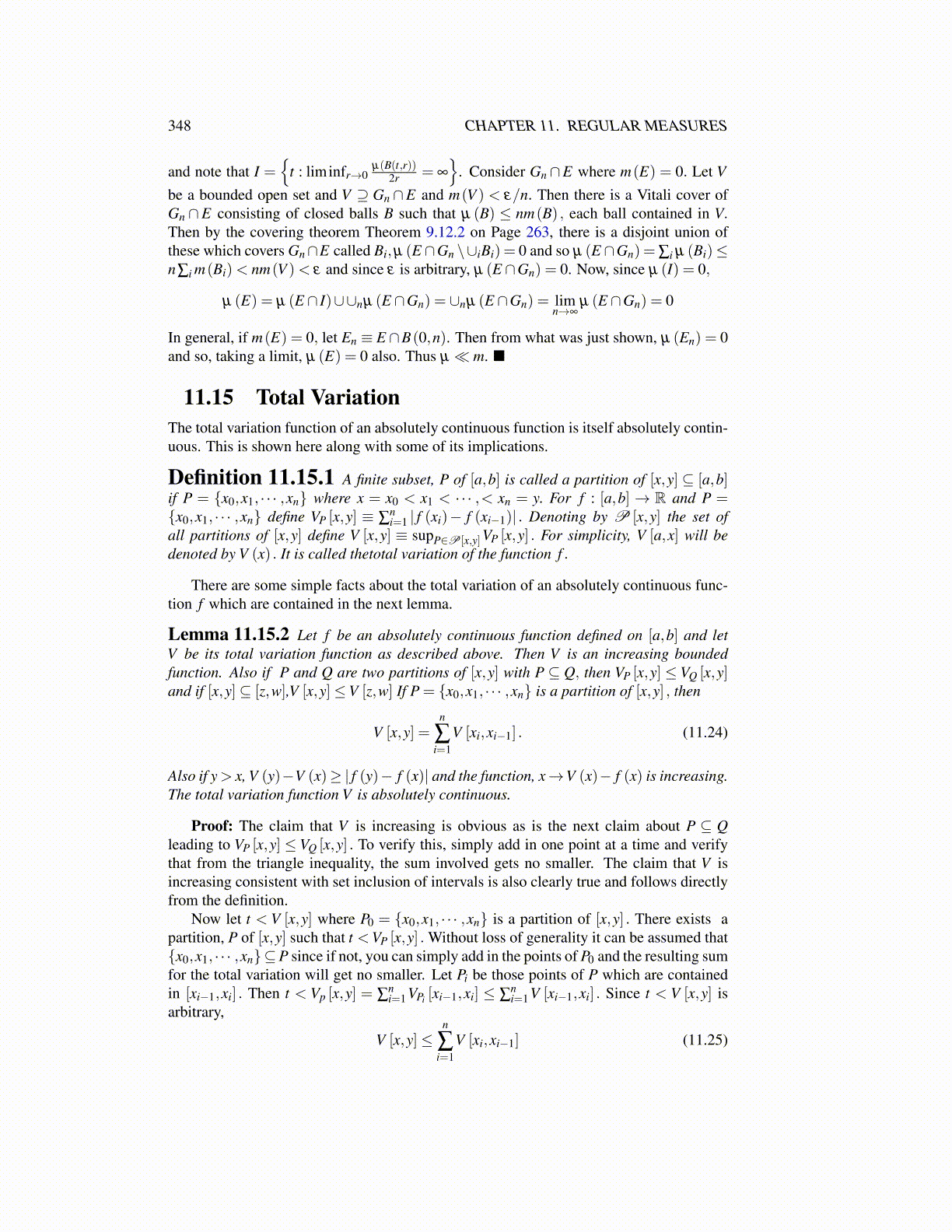
348 CHAPTER 11. REGULAR MEASURES
and note that I ={
t : liminfr→0µ(B(t,r))
2r = ∞
}. Consider Gn ∩E where m(E) = 0. Let V
be a bounded open set and V ⊇ Gn ∩E and m(V ) < ε/n. Then there is a Vitali cover ofGn ∩E consisting of closed balls B such that µ (B) ≤ nm(B) , each ball contained in V.Then by the covering theorem Theorem 9.12.2 on Page 263, there is a disjoint union ofthese which covers Gn∩E called Bi,µ (E ∩Gn \∪iBi) = 0 and so µ (E ∩Gn) = ∑i µ (Bi)≤n∑i m(Bi)< nm(V )< ε and since ε is arbitrary, µ (E ∩Gn) = 0. Now, since µ (I) = 0,
µ (E) = µ (E ∩ I)∪∪nµ (E ∩Gn) = ∪nµ (E ∩Gn) = limn→∞
µ (E ∩Gn) = 0
In general, if m(E) = 0, let En ≡ E ∩B(0,n). Then from what was just shown, µ (En) = 0and so, taking a limit, µ (E) = 0 also. Thus µ ≪ m. ■
11.15 Total VariationThe total variation function of an absolutely continuous function is itself absolutely contin-uous. This is shown here along with some of its implications.
Definition 11.15.1 A finite subset, P of [a,b] is called a partition of [x,y] ⊆ [a,b]if P = {x0,x1, · · · ,xn} where x = x0 < x1 < · · · ,< xn = y. For f : [a,b] → R and P ={x0,x1, · · · ,xn} define VP [x,y] ≡ ∑
ni=1 | f (xi)− f (xi−1)| . Denoting by P [x,y] the set of
all partitions of [x,y] define V [x,y] ≡ supP∈P[x,y]VP [x,y] . For simplicity, V [a,x] will bedenoted by V (x) . It is called thetotal variation of the function f .
There are some simple facts about the total variation of an absolutely continuous func-tion f which are contained in the next lemma.
Lemma 11.15.2 Let f be an absolutely continuous function defined on [a,b] and letV be its total variation function as described above. Then V is an increasing boundedfunction. Also if P and Q are two partitions of [x,y] with P ⊆ Q, then VP [x,y] ≤ VQ [x,y]and if [x,y]⊆ [z,w],V [x,y]≤V [z,w] If P = {x0,x1, · · · ,xn} is a partition of [x,y] , then
V [x,y] =n
∑i=1
V [xi,xi−1] . (11.24)
Also if y> x, V (y)−V (x)≥ | f (y)− f (x)| and the function, x→V (x)− f (x) is increasing.The total variation function V is absolutely continuous.
Proof: The claim that V is increasing is obvious as is the next claim about P ⊆ Qleading to VP [x,y] ≤ VQ [x,y] . To verify this, simply add in one point at a time and verifythat from the triangle inequality, the sum involved gets no smaller. The claim that V isincreasing consistent with set inclusion of intervals is also clearly true and follows directlyfrom the definition.
Now let t < V [x,y] where P0 = {x0,x1, · · · ,xn} is a partition of [x,y] . There exists apartition, P of [x,y] such that t <VP [x,y] . Without loss of generality it can be assumed that{x0,x1, · · · ,xn}⊆P since if not, you can simply add in the points of P0 and the resulting sumfor the total variation will get no smaller. Let Pi be those points of P which are containedin [xi−1,xi] . Then t < Vp [x,y] = ∑
ni=1 VPi [xi−1,xi] ≤ ∑
ni=1 V [xi−1,xi] . Since t < V [x,y] is
arbitrary,
V [x,y]≤n
∑i=1
V [xi,xi−1] (11.25)